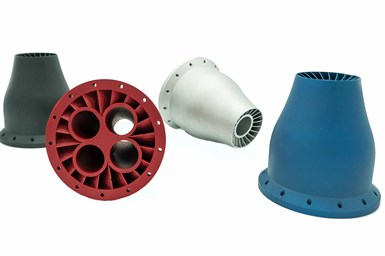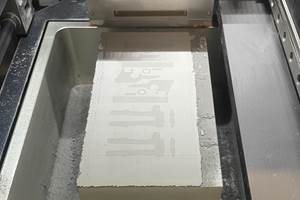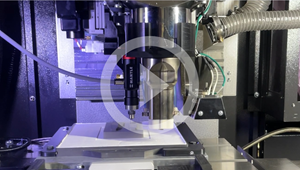EOS Aluminum Al5X1 Is High-Strength Anodizable Alloy for Industrial 3D Printing
The aluminum alloy offers light weight, high strength, elongation and corrosion resistance.
EOS’ Aluminum Al5X1 is an aluminum alloy engineered specifically for additive manufacturing (AM), but at a more competitive cost than other aluminum alloys with similar strength and elongation properties. The EOS Aluminum Al5X1 delivers excellent performance and material properties with a combination of high strength and elongation, around 410 MPa UTS and 14% elongation.
Requiring only a single-step heat treatment with no Hot Isostatic Pressing (HIP), organizations can manufacture parts faster and at a lower total cost. The 3D printed applications using EOS Aluminum Al5X1 can also be electropolished and anodized (Type II and Type III) for both cosmetic (colored) and corrosion-resistant protective properties. There are no limits to potential color choices, which could be important to consumer-facing products.
EOS Aluminum Al5X1 was tested by multiple organizations, including leading semiconductor, aerospace and defense companies. Early adopters have noted the material’s exceptional performance combined with the competitive cost-per-part (CPP) has created a strong business case for production implementation.
“Since early 2023, we have been working to develop Al5X1 performance data and material allowables on behalf of our prime customers,” says Brian Neff, Sintavia founder and CEO, a designer and additive manufacturer of mechanical systems for the aerospace and defense industry. “Preliminary results are very promising, and we look forward to introducing Al5X1 across our thermodynamic product lines. Developing a higher performing aluminum alloy is of critical importance not only to us, but also to the industry as a whole.”
A combination of high strength and high elongation for an aluminum alloy is critical for manufacturers in industries like aerospace. “But equally crucial is delivering the property combination at a reasonable cost,” says Dr. Ankit Saharan, EOS senior manager of metals technology. “Also interesting is that since the material can be anodized, this makes it very attractive to OEMs in areas like consumer electronics who are seeking to produce different colored products to suit customers’ preferences, with the added bonus of corrosion resistance.”
- Read about EOS developing sustainable polymers for additive manufacturing. The climate-neutral PA 1101 and carbon-reduced PA 2200 polymer materials are designed to increase production efficiency, while supporting more sustainable additive manufacturing.
- Learn about the EOS collaboration with nTop to create file capability that would limit design data bottlenecks. EOS and nTop have created a new nTop Implicit File that can result in up to 99% smaller file sizes, 500 times faster file generation and 60% faster load time, making it more readily available to additive manufacturing build preparation software for manufacturing.
Related Content
How Norsk Titanium Is Scaling Up AM Production — and Employment — in New York State
New opportunities for part production via the company’s forging-like additive process are coming from the aerospace industry as well as a different sector, the semiconductor industry.
Read MoreAM 101: What Is Binder Jetting? (Includes Video)
Binder jetting requires no support structures, is accurate and repeatable, and is said to eliminate dimensional distortion problems common in some high-heat 3D technologies. Here is a look at how binder jetting works and its benefits for additive manufacturing.
Read MoreAdditive Manufacturing Is Subtractive, Too: How CNC Machining Integrates With AM (Includes Video)
For Keselowski Advanced Manufacturing, succeeding with laser powder bed fusion as a production process means developing a machine shop that is responsive to, and moves at the pacing of, metal 3D printing.
Read More3D Printing Molds With Metal Paste: The Mantle Process Explained (Video)
Metal paste is the starting point for a process using 3D printing, CNC shaping and sintering to deliver precise H13 or P20 steel tooling for plastics injection molding. Peter Zelinski talks through the steps of the process in this video filmed with Mantle equipment.
Read MoreRead Next
3D Printed Polymer EOAT Increases Safety of Cobots
Contract manufacturer Anubis 3D applies polymer 3D printing processes to manufacture cobot tooling that is lightweight, smooth and safer for human interaction.
Read MoreAlquist 3D Looks Toward a Carbon-Sequestering Future with 3D Printed Infrastructure
The Colorado startup aims to reduce the carbon footprint of new buildings, homes and city infrastructure with robotic 3D printing and a specialized geopolymer material.
Read MoreCrushable Lattices: The Lightweight Structures That Will Protect an Interplanetary Payload
NASA uses laser powder bed fusion plus chemical etching to create the lattice forms engineered to keep Mars rocks safe during a crash landing on Earth.
Read More





















